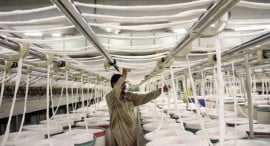
KARACHI:
Unlike many newlyweds in interior Sindh, Sharifa and Yaru didn’t have their first child within a year of marriage. Six years and two miscarriages later – one almost costing Sharifa her life – the couple finally had a baby boy they named Amin.
Complications during Sharifa’s premature delivery and emergency caesarean required the mother and son to receive a blood transfusion and a course of injections. Luckily though, both were soon declared fit.
After spending the last five years working in the Gulf, Yaru decided to quit his job to spend time at home.
However, what should have been a happy ending for the small rural family turned into a nightmare when, four years later, Amin was brought in for a check-up to Karachi and tested positive for HIV.
“I just brought him to check for the flu,” Sharifa said, unable to control her tears. Amin would fall ill more frequently than other children and would take much longer to recover as well.
UNAIDS says there are about 85,000 to 125,000 infected people in Pakistan. But Head of Infectious Diseases at Sindh Institute of Urology and Transplantation Dr Shehla Baqi expects the numbers to be much higher. Experts say that a majority of cases in Sindh are emerging from Sukkur, Larkana and Ghotki.
Main sources of transmission
“In the 90s and 2000s a major chunk of HIV cases were labourers who were deported from Gulf States,” says former head of Sindh’s HIV/Aids surveillance project Dr Arshad Altaf. On their return these men would pass on the virus to their wives.
“Transsexual sex workers emerged as the second highest risk group comprising almost five per cent of the overall pool.”
Presently though Baqi says, “Injecting drug users (IDU) are a major risk factor. Most IDUs also engage in high risk sexual practices but are most likely infected through injection use.”
Dr Tayyaba Rashid of the Punjab Aids Control Programme agrees. “Contaminated needles by IDUs are the driving cause behind the epidemic, however, quackery has also contributed to the spread.”
Off-the-radar sources
Still, IDUs and promiscuity with sex workers do not explain how Amin was infected with the deadly virus.
Chair of Paediatrics at the Aga Khan University Hospital Dr Anita Zaidi says there is a 30% risk of infection transfer from a mother to child. “Ten per cent risk during the intra uterine phase, 10% during the birth process and 10% from breast milk,” she said.
Many mothers aware of their infection insist on breastfeeding their children fearing their in-laws will learn of their condition and ostracise them. Experts say children born with the infection will most likely not survive beyond 10 years of age.
Chief Executive Officer for Shaukat Khanum Memorial Cancer Hospital Dr Faisal Sultan has worked extensively with HIV and Aids patients. During their research, Sultan and his colleagues found a disproportionate number of cases in Jalalpur Jattan in Gujrat district. “For its small population, there have been hundreds of cases reported [from the area],” Sultan says.
Adding weight to this theory, many couples were disconcordant – meaning the husband tested negative while the wife was HIV positive or vice versa. Other cases, similar to Amin’s, were where the husband and wife were negative but the child(ren), many of them prepubescent, tested positive.
“The obvious conclusion is the spread is not via sexual transmission,” Sultan said. Proposed methods of transmission include transfusion of unscreened infected blood and reuse of contaminated syringes by healthcare providers, mostly in informal setups.
“This is what makes sense,” Sultan says, cautiously adding, “But nothing can be said with confidence as there is no proof to substantiate it.”
Published in The Express Tribune, December 1st, 2011.
COMMENTS (1)
Comments are moderated and generally will be posted if they are on-topic and not abusive.
For more information, please see our Comments FAQ

















































Not enough is being done by the government to tackle this growing menace.